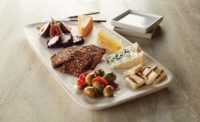Cap Goes Back To “Children At Play”
Roots
By Renee Covino
Cap Candy, a division of
Hasbro Toys, is literally “playing up” its original strength in
the kid candy business, now under the direction of Bob Nations, vice
president of global marketing and sales, and Julie Nunn, director of
marketing.
Cap, a name that was created as an acronym for
Children At Play, is “refocusing its efforts around that
theme,” and will even include the words “children at
play” in its logo, according to Nations, whose role was expanded in
November to include the general management of the company.
“We decided to use our Hasbro toy affiliation
much more to its strengths,” adds Nunn.
The effort is, in part, a timely response to the child
obesity issue. “The most important thing we sell is a play experience
that happens to have a small quantity of candy,” says Nations.
“With regard to the obesity issue in our industry, it makes perfect
sense to emphasize the activities and experiential fun with modest treats,
rather than pure candy,” Nunn maintains.
New products with that emphasis will be incorporated
into the Cap line, but “our products take 12-18 months to come to
market, so we won’t see the results until next year,” reports
Nations. “But the criteria are that they will encourage the child to
play. We don’t want sedentary kids.”
“Good-for-you types of candy” will be
researched by Cap as another means to address responsible candy marketing,
according to Nations. This includes options that are fruit-juice fortified,
under 200 calories, and under 10 grams of sugar. Wrappers will also reflect
calorie counts, such as the company’s little lollipops, which are 50
calories.
Cap Candy will continue to be licensed-focused in its
“children at play” strategy, as it has always been. “But
we’re not going after licenses just because they’re hot; they
have to make sense for candy and Cap’s strategy,” says Nunn.
“Our classic Harry Potter license fits this perfectly and we’ll
continue with that through 2007.”
Other big licenses from Cap this year will include
“Transformers,” the movie, and “Spider-Man 3.”
Twelve leaders in the candy industry were honored this
spring when they were inducted into the Candy Hall of Fame. Inductees,
seated left to right, are: Bill Wiltsie, Sr., Wiltsie & Co., Inc.;
Susan Smith, National Confectioners Association; Brian Jackson, Jackson
Associates; Elaine Gonzalez, Chocolate Artistry; and Rick LaRue,
Goetze’s Candy Co., Inc. (retired). Standing left to right are:
Bernie Nadel, Ferrero USA, Inc. (retired); Bill Raleigh, SPI Polyols Inc.;
Bob Pontes, Auburn Merchandise Distributors, Inc.; Tony Sweet, Sweet Candy
Co.; John L. Asher, Jr., Asher’s Chocolates; and Ross Bainbridge,
Bainbridge Associates, LLC. Not pictured: Russ Albers, Jelly Belly Candy
Co.
Also honored posthumously were: Oliver Chase, inventor
of the first American candy making machine and founder of NECCO, and Sam
Born, founder of Just Born Inc. and inventor of a machine to automatically
insert sticks into lollipops.
The Science of Gum Chewing Studied
To expand on research from around the world suggesting
chewing gum may offer health, wellness and lifestyle benefits, The Wm.
Wrigley Jr. Company, Chicago, has established the Wrigley Science Institute
(WSI) to study whether chewing gum may aid in weight management, stress
relief and increasing alertness and concentration.
Gilbert A. Leveille, Ph.D., will lead an advisory
panel of top scientists, including researchers from the United States,
United Kingdom and China.
During 2006, the Institute expects to support at least
10 groundbreaking research studies. Three to four U.S. and U.K. studies
probe the role chewing gum may play in appetite control and weight
management; three U.K. and Asian studies focus on the role chewing gum may
have in increasing focus and concentration, and three studies in the United
States and United Kingdom assess how chewing may help reduce stress.
Existing research suggests that the act of chewing gum
increases blood flow to the brain by at least 25 percent, and that chewing
gum appears to improve the ability to retain and retrieve information.
Research also suggests that chewing gum can reduce caloric intake by
serving as a diversion between meals and a prevention to “mindless
munching.”
As chief executive officer and owner of The Jay Group,
a Ronks, Pa.-based marketing and logistics fulfillment company, Dana Chryst
knows all about providing behind-the-scenes services.
That is precisely what her company does for a long
list of manufacturer clients, a list that has included confections
companies such as Just Born and Lindt USA. The Jay Group offers a
cafeteria-list of “fulfillment” services for vendors seeking to
outsource some of the behind-the-scenes promotion and logistics services.
The company’s capabilities range from managing promotions (everything
from procuring display components to handling the logistics of shipping
them to stores) to operating consumer call-in centers and handling
e-commerce functions.
For Lindt, the Jay Group fulfills customized gift
basket orders generated online and through Lindt stores around the country.
During holiday seasons, the number of orders processed can reach a total of
more than 6,000 monthly. To ensure that orders are fulfilled accurately and
quickly, the Jay Group’s order management system ties directly to the
Lindt USA e-commerce Web site.
The Jay Group helped Just Born set up an online
merchandise store for Peeps branded merchandise that was seamlessly
connected to Just Born’s Web site.
Chryst recently took some time out to chat with Confectioner about how
smooth execution of marketing and promotion initiatives enhances a brand
experience.
Q: Why are the services of a fulfillment company
valuable to vendors and retailers?
A: “The
manufacturer spends so much time and money developing the brand, it’s
critical that they deliver the brand to the consumer and the retailer in a
way that consistently fulfills the brand.”
Q: How do you help manufacturers achieve such goals?
A: “We try to create promotions that are intuitive and
easy for the retailer to execute. In each of these scenarios, we bring
expertise that isn’t just logistics. It’s marketing logistics.
It’s one thing to say, ‘What do I need to do to get a product
to its destination safely?’ It’s another thing to say,
‘How do I create a corrugated display that will reinforce the brand
image for the whole time it’s on display?”
Q: How has online ordering capability affected
consumers’ expectations?
A: “Same-day
shipping appears to be an expectation, particularly in the area of
confections. People who order online expect things easy, fast and perfect.
Diamond Makes Deal for Harmony
Leading snack nut producer Diamond Foods Inc. has paid
$18 million in cash and assumed defined liabilities for Harmony
Foods’ leased processing and packaging plant in Fisher, Ind.; the
Harmony and Homa brands, and $4.5 million of working capital and other
assets.
The strategically located 187,000 square foot plant,
which will provide Diamond two-day or less shipping time to key customers,
produces trail mixes, specialty dried fruits, nuts, seeds, sweet
snacks and organic snacks in multiple packaging options.
Diamond will relocate its production activities to the
Indiana plant from its current Lemont, Ill., facility, a move it expects
will save $2 million annually.
The deal also expands Diamond’s merchandising
footprint in both the snack and produce aisles, as well as enabling a
year-round presence in the produce aisle.
Diamond expects this expansion into complementary
products such as sweet, sweet/salty, natural and organic products, in
addition to its Diamond and Emerald brand products, to drive fiscal 2007
snack sales past $80 million
Free Wrigley Website Expands Games, Online Shopping
Options
Candystand.com, the Chicago-based Wm. Wrigley Jr.
Company’s free entertainment Website, has been overhauled to house
all of Wrigley’s U.S. brands and additional games.
Consumers can now go to the site’s Candy Shop
and purchase popular Wrigley brands such as Big Red, Juicy Fruit,
Winterfresh, Doublemint, Orbit and Eclipse in addition to the site’s
existing stable of Life Savers and Crème Savers products. In
addition, the user-experience has been streamlined and new entertainment
content has been added.
Wrigley acquired Candystand.com in 2005. One of the
most popular Web destinations, featuring sports, arcade, card, puzzle and
multiplayer games, it is visited by more than 4 million people each month
and has been in existence since 1997. Two new games, HORSE and Out of
Bounds Tennis, have been added, and in the near future, Monster Trucks, GT
Auto, Mini Golf and Skyburst will be available. Candystand also offers an
array of contests in its sweepstakes center.
Jelly Belly Mystique Will Extend to New Product
Categories
The distinctive colors, shapes — and in some
cases flavors and scents — of Jelly Belly jelly beans will soon be
found on items including pillows, board books and apparel, thanks to
licensing agreements orchestrated by The Licensing Company North America,
N.Y., N.Y.
Every licensed product will leverage at least one of
the four core Jelly Belly jelly bean attributes — flavor, scent,
color and shape, says Risa Turken, managing director of The Licensing
Company.
“When looking for brands that make sense to
extend, they have to have a unique personality and identifiable
assets,” and Jelly Belly jelly beans meet those requirements easily,
says Turken. “Jelly Belly is such a fun brand,” she continues,
adding that the key to successfully extending it into new product
categories is “leveraging that fun.” Here’s a preview of
some of the new licensed Jelly Belly products now in the works.
Novelty pillows, beanbags and pet beds from
Senario are scheduled for rollout at mid-tier department and specialty
stores in fall 2006.
Jelly Belly bean-inspired fashion tops for
juniors and young women from Jerry Leigh will be launched in spring 2007 to
be followed later by tops for men and girls.
Penguin Young Readers Group will unveil infant
board books in time for Valentine’s Day 2007.
Also scheduled for Spring 2007 rollout is a
line of food and beverage gift sets from Shonfeld’s. The sets will
include cocktail mixers, dessert syrups, smoothie mixes and jams and
jellies.
Ann Daw, 51, is the new
president of the National Association for the Specialty Food Trade. Daw has
27 years of international business and marketing experience with Kraft and
Philip Morris. She has also worked as a consultant, focusing on business
strategies and domestic and international brand building for clients of all
sizes.
Hawaiian Host, manufacturer of Hawaiian Host
Chocolates, has named Stephanie Yamamoto sales coordinator/administrative assistant, based at
the Gardena, Calif., plant.
Organic Surge
Traditional retailers’ innovative new formats
and private label lines are transforming the high-growth natural and
organics segment, IRI reports. With 13 percent dollar sales growth, the
natural organic market is far outpacing total CPG growth. The net effect
will be greater accessibility for consumers and lower prices.
For the full report, visit www.infores.com/public/us/newsEvents/thoughtleadership/tt_jan06.pdf
Stress Busters: Fat, Carbs and Sugar
Attention, food police. This is a reality check.
Current medical guidelines and health food choices don’t fit American
lifestyle realities, according to a study from Landis Strategy &
Innovation, Palm Beach Gardens, Fla.
More than 1,000 U.S.
consumers were the basis for the study, “Evolving Consumer Choice and
Wellbeing: Fat, Carbs and Sugar Still Rule,” which contends that
brand manufacturers and health experts must “retire the philosophies
of the old paradigm that required consumers to change entrenched behaviors
to fit product agendas and accept a new healthy living paradigm that
introduces breakthrough thinking and product innovations more congruent
with varied American health mind frames, lifestyles and
circumstances.”
Translation: The study found that consumers know what
a healthy lifestyle is all about and recognize foods that fit with sensible
eating, but they struggle to eat sensibly when stressed.
The survey resulted in seven profiles of
consumers’ health beliefs and value systems that guide choices and
actions. But the gist of the study is that stress and the ability to cope
with it are tied to success or failure of any approach to food.
For details, visit www.landis-si.com. and click
on “Landis Knowledge Resources.”
—PLEASE CREATE PIE CHART USING THIS DATA—
Shopping Trips by Type
Small Trips/Immediate Needs 69%
Medium Trips/Fill In 18%
Large Trip/Weekly Shopping 9%
Extra-Large Trip/Stock-up 4%
Source: ACNielsen – Homescan for 52 weeks ending
July 2, 2005
—stock art of someone eating or looking
stressed—
—data for chart below—
Attracting Consumers’ Attention
To New Products Just Isn’t Easy
Packaged goods manufacturers launched more than 30,000
new products last year, and the majority of consumers (57 percent) could
not recall a single one of them, according to the 2005 Schneider/Stagnito
Communications Most Memorable New Product Launch Survey.
The survey polled more than 10,000 consumers to
generate a list of the year’s 10 “most memorable” new
product launches. Topping the list — tied with 23 percent of the vote
each — were Microsoft’s Xbox 360 and McDonald’s Fruit
& Walnut salad. No candy items made the top 10 list, which also
included Coca-Cola Zero, Hummer H3, Cocoa-Cola with Lime, Apple’s
iPod nano, Tide to Go, Apple’s iPod (not the nano version), Budweiser
Select and Clorox Bath Wand.
The survey findings call attention to the challenge
packaged goods marketers face, points out Joan Schneider, president of
Schneider Associates, a Boston-based marketing communications firm, and the
originator of the survey.
“With only 16 percent of consumers polled
characterizing themselves as early adopters,” Schneider continued,
“marketers need to appeal to the 84 percent of consumers who
don’t want to try or buy their new products.”
—chart or boxed item to go with story
above—
Attention Attractors
(Top factors that consumers said influenced their
awareness of new products)
Factors Percent Cited
Television Ads 80%
Free Samples 55%
In-Store Displays 62%
Recommendations from Family and Friends 52%
Received a Coupon or Flyer 47%
In-Store Free Samples 45%
Source: 2005 Schneider/Stagnito Communications Most
Memorable New Product Launch Survey
—News Briefs—these can be shortened,
I’m grouping them all together basically because they’re all
short newsy items; first two are most important —-
Founders Equity Acquires Richardson Brands
Private equity investor Founders Equity Inc. has
acquired niche confectioner Richardson Brands Group. Terms were not
disclosed.
Richardson, established in 1893, produces
confectionery products such as Richardson brand soft sugar mints, chewy
candies and Beechies brand coated gum at its 180,000 square foot facility
in Canajoharie, N.Y. The company, which also is the U.S. sales, marketing
and distribution arm of Colombina branded candies, is headquartered in
Miami.
The management team of Don Butte as CEO and George
Lasher as CFO have more than 75 years combined experience with firms such
as Kraft, Nabisco and General Foods.
—no art—
Supermarkets Post Strong Sales Growth
Same-store supermarket sales rose the highest they
have in a decade — 3 percent — for 2005, while overall
supermarket industry sales increased 4.6 percent, according to Food
Retailing Industry Speaks, 2006, the annual state-of-the-industry report of
the Food Marketing Institute (FMI).
Independent retailers scored the largest gains in
same-store and overall sales, at 4.56 percent and 4.73 percent,
respectively.
The large chains are succeeding with technology,
efficiency and new store formats that cater to consumers’ lifestyles;
the smaller retailers succeed by meeting customer needs, observes Tim
Hammonds, FMI president and CEO.
Among the developments noted by the report,
self-checkout lanes are now a standard supermarket feature, offered by
three-quarters of stores. In addition, more retailers are offering shoppers
a quick-stop, prepared foods department for take-out meals. Nearly 40
percent — 39.8 percent — offer this service, a more than
10-point increase from last year, when only 28.2 percent did. Almost 7 in
10 stores – 68 percent – feature coffee bars.
C-Store Revenue Up 20 Percent
Convenience store sales experienced double-digit
growth for the third straight year, reaching a record $474.3 billion in
2005 on a sales increase of 20.2 percent, according to the National
Association of Convenience Stores (NACS). NACS figures are based on a
survey of more than 21,000 convenience and petroleum retailers nationwide.
Leading the increase was a 26.2 percent rise in
gasoline prices, which lead to a 25.5 percent spike in motor fuels revenues
to $329.5 billion in 2005. In-store revenues were also strong, posting a
9.6 percent increase to $144.8 billion. Merchandise revenues were up 9.7
percent to reach $127.6 billion and foodservice revenues grew 8.8 percent
to $17.2 billion.
For the first time in history, on a per-store basis,
combined in-store sales topped $1 million per store, reaching $1.036
million per store. Overall industry profits were strong, jumping 17.1
percent to $5.84 billion, making 2005 the third straight year that pretax
profits increased.
Spangler Celebrates Life’s Small, Sweet Gestures
A select group of life’s unsung heroes will get
their due as part of an essay contest sponsored by Spangler Candy Co.,
makers of Dum Dum Pops. The “Make Life a Little Sweeter”
contest, held as part of Spangler’s 100th anniversary celebration, is
designed to recognize those who (like the company’s lollipops)
brighten the lives of others through small gestures of kindness and
generosity.
Those who wish to enter may go to www.dumdumpops.com
and click on the contest link to submit stories that epitomize a spirit of
generosity and goodwill in everyday life. One winner will be chosen in each
of three age groups — 13-18, 19-55, and 56+ — to receive a
$1,000 cash prize and a case of 2,000 Dum Dum Pops. Fifty first-prize
winners in each age group also will receive candy and t-shirts. Winners
will be announced in September 2006.
Top Activities While Eating Chocolate Candy/Candy Bars
* Watching TV (28 percent of the time)
* Work or homework/break from work
* Not doing anything in particular
* Traveling/driving in car
* Surfing the Web
Consumption is defined as an "eating," a
unit of measure indicating that the behavior occurred. An eating does not
indicate amount consumed by each person. Source: The NPD Group/SnackTrack






